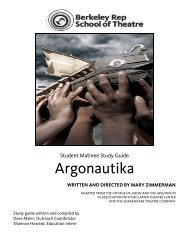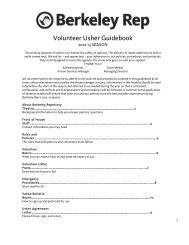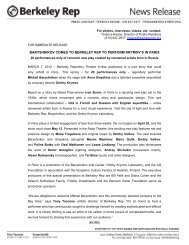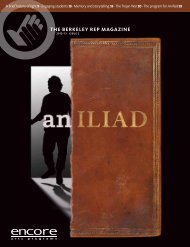Five Questions for Mary Zimmerman - Berkeley Repertory Theatre
Five Questions for Mary Zimmerman - Berkeley Repertory Theatre
Five Questions for Mary Zimmerman - Berkeley Repertory Theatre
Create successful ePaper yourself
Turn your PDF publications into a flip-book with our unique Google optimized e-Paper software.
TABLE OF CONTENTS<br />
<strong>Five</strong> <strong>Questions</strong> <strong>for</strong> <strong>Mary</strong> <strong>Zimmerman</strong>………………………………………………………………………………………..…4<br />
A Thousand and One Nights: The endless unfolding of a living document<br />
By Alex Rosenthal……………………………………………………………………………………………………………………….6<br />
Geography of The Arabian Nights………………………………………………………………………………………………..8<br />
Adaptations of The Arabian Nights……………………………………………………………………………….…………..10<br />
Glossary of Terms used in The Arabian Nights…………………………………………………………………………….12<br />
Discussion <strong>Questions</strong>……………………………………………………………………..……………………………….………..14<br />
Covering the above material in class fulfills the following Language Arts Standards.<br />
Reading<br />
Grade 6: 1.3, 1.4, 2.2, 3.2, 3.4, 4.6<br />
Grade 7: 1.1, 2.3, 3.2, 3.3, 3.4<br />
Grade 8: 2.3, 3.2, 3.5, 3.7<br />
Grades 9 & 10: 3.9<br />
Grades 11& 12: 3.9<br />
Covering the above material fulfill the following standards <strong>for</strong> History and Social Science<br />
Framework <strong>for</strong> Cali<strong>for</strong>nia Public Schools<br />
Seventh Grade World History and Geography: Medieval and Early Modern Times<br />
Standard 7.2- Students analyze the geographic, political, economic, religious, and<br />
social structures of the civilizations of Islam in the Middle Ages.<br />
Tenth Grade World History, Culture, and Geography: The Modern World<br />
Standard 10.10- Students analyze instances of nation-building in the contemporary<br />
world in at least two of the following regions or countries: the Middle East, Africa,<br />
Mexico and other parts of Latin America, and China<br />
Activities…………………………………………………………………………………………………………………………………..15<br />
Covering the above material in class fulfills the following Language Arts Standards.<br />
Writing<br />
Grades 6-12 : 2.1<br />
Listening and Speaking<br />
Grades 6-12: 2.1<br />
Covering the above activities in class fulfills the following (Visual and Per<strong>for</strong>ming Arts)<br />
Standards.<br />
2
Grade 6<br />
1.1(Artistic Perception)<br />
2.2 (Creative Expression)<br />
2.3 (Creative Expression)<br />
3.2 (Historical and Cultural Context)<br />
Grade 7<br />
1.1(Artistic Perception)<br />
4.2 (Aesthetic Valuing)<br />
Grade 8<br />
1.1(Artistic Perception)<br />
2.1 (Creative Expression)<br />
Grades 9-12<br />
1.1, 1.2 (Artistic Perception)<br />
2.1 (Creative Expression)<br />
3.2 (Historical and Cultural Context)<br />
4.2 (Aesthetic Valuing)<br />
3
<strong>Five</strong> <strong>Questions</strong> <strong>for</strong> <strong>Mary</strong> <strong>Zimmerman</strong> on The Arabian Nights<br />
What first drew you to this particular collection of stories?<br />
The first production of The Arabian Nights was made by myself<br />
and the Lookingglass <strong>Theatre</strong> Company of Chicago in 1992 in the<br />
shadow of the first Gulf War. The project was inspired in particular<br />
by two things I saw on television: one was a military official<br />
boasting that we would bomb Iraq "back to the stone age;" the<br />
other was a report on the nightly news concerning infant mortality<br />
in the Middle East. The gist of this report was that women over<br />
there had a whole lot of children and expected to lose a few along<br />
the way -- the implication being that an Iraqi mother would<br />
somehow experience the death of her child less acutely than, say,<br />
oneself.<br />
Are you saying that you believe certain feelings are universal, or<br />
perhaps that we share an essential common humanity?<br />
It is a precondition of war that we view other people as fundamentally different from ourselves; it is a<br />
precondition of literature that we view other people as fundamentally the same. All my life I've found<br />
myself in the ancient stories of faraway places and I've always drawn com<strong>for</strong>t from the feeling "it was<br />
ever thus" with all of us: that we will experience violent change and loss; that we will look <strong>for</strong> love and<br />
betray it; that we will make errors, both serious and trivial that make us feel embarrassed or ashamed<br />
all our lives; that certain things will always be funny and others always sad. Although this seems utterly<br />
self-evident, wartime works towards the erosion of empathy, explicitly delimiting the idea that all men<br />
are brothers.<br />
How, specifically, did politics and current events enter your thinking when you actually sat down to<br />
envision what this play would look like?<br />
Be<strong>for</strong>e beginning rehearsals <strong>for</strong> the first Arabian Nights (which, because of the way I work also means<br />
be<strong>for</strong>e beginning to write it) I was full of a great many theoretical and overtly political ideas <strong>for</strong> its<br />
staging that would call attention to is contemporary relevance. Yet the moment we began actually to<br />
embody these stories virtually all of these preconceived ideas went right out the window. The stories<br />
spoke more than loudly enough <strong>for</strong> themselves: their humanity, wisdom, humor, vulgarity, and poetry<br />
were manifest, and with their tremendous will towards life they took over the rehearsal room as easily<br />
as they take over King Shahryar. Almost none of that original impulse towards overt commentary<br />
remains.<br />
4
<strong>Five</strong> <strong>Questions</strong> (cont.)<br />
What can you share with us about your view of Scheherezade’s situation and her relationship with<br />
Shahryar?<br />
Scheherezade knows the power of these stories. By populating the darkened, isolated chamber of<br />
Shahryar with imaginary characters she coaxes the murderous king back into the real world. Narrative<br />
alters the course of reality and "the daughters of the Musselmen" are saved.<br />
What do these stories tell us about ourselves and our world today?<br />
Although even the happy stories in The Arabian Nights often end with an evocation of the finality of<br />
death, the overall impression is the enduring, trans<strong>for</strong>mative power of narrative. In the tale of "The<br />
Mock Kalifah," the great ruler Harun al-Rashid, disguised as a simple merchant, hides under a bridge<br />
and watches a simple merchant disguised as Harun al-Rashid drift down the Tigris on an illuminated<br />
boat. Each man aches to be the other. Since 2003 the ancient bridge whose shadows once hid Harun no<br />
longer exists, but the story, part of the eternal bridge to Baghdad, does.<br />
To save her life, Scherezade (Sofia Jean Gomez) must tell tales to the king (Ryan Artzberger).<br />
5
A Thousand and One Nights:<br />
The endless unfolding of a living document<br />
By Alex Rosenthal<br />
Dawn is deadly <strong>for</strong> Scheherezade. The sun’s rising each day marks the scheduled hour of her execution,<br />
which she can only defer with one tool: the cliffhanger. This device saves Scheherezade repeatedly, and<br />
in the process buys her the time she needs to spin together the story she will tell the following night. In<br />
this way she creates the series of stories collectively known as The Arabian Nights. These stories have<br />
been translated and adapted scores of times over the last millennium. In fact, the history of The<br />
Arabian Nights is as full of twists as the narratives within its pages. But the original collection and its<br />
subsequent retellings would have never held together without a binding frame story, which<br />
Scheherezade’s predicament has provided <strong>for</strong> the entertainment of countless cultures and generations.<br />
The basic frame story is as follows: King Shahryar, having walked in on his wife in the throes of passion<br />
with another man, has begun marrying a virgin every night and killing her the next morning to ensure<br />
he’ll never be betrayed again. When it is Scheherezade’s turn, she devises a plan to save herself and the<br />
country’s dwindling population of virgins. She will tell the king a series of sexy, magical, action-packed<br />
stories and be sure to leave off at crucial moments, thereby <strong>for</strong>cing Shahryar to keep her alive <strong>for</strong> one<br />
more day so that he can satiate his burning need <strong>for</strong> resolution. Scheherazade has everything riding on<br />
the success her stories; if she loses Shahryar’s interest or finishes a story too soon, her life is <strong>for</strong>feit.<br />
Scheherezade’s conundrum dates back over a thousand years, and, much like Homer’s Odyssey and<br />
other classical works, finds its origins in an oral storytelling tradition. This makes it essentially<br />
impossible to trace a particular story within the collection of The Arabian Nights to its inception.<br />
However, one of the first recorded references to Scheherezade’s story was found in the writings of<br />
tenth century Arab historians. They described collections of stories, framed by Scheherezade and<br />
broken into divisions of nights, much like The Arabian Nights which we are familiar with. These early<br />
collections, which have since been lost, provided the foundation <strong>for</strong> a 13th century document from the<br />
vicinity of Syria and Egypt, which is the definitive ancestor of what we have today. In the centuries<br />
since the publication of this document, the collection that is The Arabian Nights has accrued stories<br />
from a variety of cultures in a sort of literary snowball effect.<br />
This accumulation of stories began when the meaning of the title was lost in translation. Originally, “a<br />
thousand and one” translated to an uncountable number, such as we might say “infinity plus one”<br />
today. In actuality, the 13th century document had far fewer than a thousand and one night’s worth of<br />
stories. When the text was copied and translated into later editions, popular outcry rang out <strong>for</strong> a full<br />
body of text with the promised quantity of tales. This demand compelled the authors to add tales from<br />
Indian, Persian, Turkish, and other oral and literary traditions. The frequently adapted tale of Sinbad<br />
the Sailor is one of these late additions. Of perhaps even more dubious origin is the story of Aladdin,<br />
which purportedly was one of the original Arabian Nights stories. However, Aladdin did not appear in<br />
print until the first European translation of The Arabian Nights was written by Antoine Galland in early<br />
18th century France. Galland claims to have heard the story from a Syrian storyteller, but some critics<br />
contend that he may have fabricated the tale himself, making Aladdin French in origin. Translators in<br />
various western cultures continued the tradition of cutting and adding stories to fit their needs and<br />
audiences, thus contributing to the colorful pastiche of anecdotes, moral tales, and lascivious<br />
encounters that comprise most modern editions of The Arabian Nights.<br />
6
The historical continuum of fascination with these stories begs the question: why do people keep<br />
returning to them across generational and cultural lines? Husain Haddawy, translator of a recent<br />
edition of The Arabian Nights, suggests that their original purpose was as “a collection of tales told to<br />
produce aesthetic pleasure in the Arabic reader.” This notion of the tales as providing pleasurable<br />
entertainment is a primary attraction of the text shared by readers across history. The stories are<br />
delightfully fun; each provides a rollercoaster ride of descriptive passages that build tension and<br />
heighten anticipation interspersed with thrilling freefalls of heroic exploits and adventures. Action<br />
unfolds with magical twists and emotional reveals on top of humorous and often sexual situations. And<br />
there is a pervading feeling of constant unfolding: everything and everyone has a story to tell, each<br />
more wondrous than the last, until we find ourselves in a frame within a frame within a frame within a<br />
frame, every level commenting and interacting with the others. Scheherezade is, after all, quite good at<br />
her job, and manages to ensnare her king and reader in the same tantalizing web of stories.<br />
People keep coming back to these tales <strong>for</strong> more than just the thrill of the ride, however. For 18 th and<br />
19 th century European readers, much of the appeal came from a fascination with the Eastern “other.”<br />
One of the primary Victorian translators of the text, Edward Lane, proffered the work as a travel guide<br />
to Cairo, Damascus, and Baghdad, supposedly providing an accurate account of both the contemporary<br />
Middle East and the original period of the tales. In this way the Nights was used to exotify the social<br />
values and customs of Eastern culture. In contrast, other works inspired by The Arabian Nights such as<br />
Edgar Allan Poe’s The Thousand and Second Tale of Scheherazade and Salman Rushdie’s Haroun and<br />
the Sea of Stories employ the stories as a lens through which cultures may examine themselves. Poe’s<br />
story comments on the technological boons of the industrial revolution, and Rushdie’s is an analogy <strong>for</strong><br />
present-day India. There are also instances of the tales being used as a vehicle with which to stereotype<br />
another culture; look no further than Popeye the Sailor Meets Ali Baba’s Forty Thieves <strong>for</strong> an example.<br />
The richness of the stories and the compelling nature of their structure have inspired many<br />
adaptations, and the versatility of the text has given artists a great deal to explore and expand upon.<br />
Into this mix of narrative and historical frames comes <strong>Mary</strong> <strong>Zimmerman</strong>’s The Arabian Nights, a<br />
dramatization of a select few of the hundreds of stories which have come to be associated with the<br />
complete canon in its variety of manifestations. In a way, the history of The Arabian Nights has turned<br />
it into a living document, one that encourages artists to engage with it as participants and become<br />
folded up in its pages. The adaptor takes on qualities of both Shahryar, the listener, and Scherezade,<br />
the storyteller. As Shahryar, the adaptor must first soak in the existing stories as told by prior<br />
generations of authors and translators, all the while demanding reasons to continue the collection’s<br />
life. Then, as Scheherezade, the adaptor seeks to entertain and enlighten her audience with something<br />
new and pertinent to them. <strong>Zimmerman</strong> fills the role of adaptor by bringing a new dimension of life to<br />
the text. Present here are the narrative frames, the love-addled characters, the wind-swept deserts, and<br />
the flowing verses that make the original document instantly recognizable. Layered on top of this are<br />
sensory experiences which provoke the imagination in ways that only live theatre can achieve. For<br />
instance, in the original document, the text reminds us that every morning Shahryar intends to kill<br />
Scheherezade but holds off in order to hear the end of her story. <strong>Zimmerman</strong>, however, actually shows<br />
Shahryar pressing a dagger to Scheherezade’s throat, adding a sense of immediacy and visceral danger.<br />
Throughout the play, live music and physical movements supplement the textual rhythms and<br />
repetitions already present. Flurries of activity and explosions of color assault the senses and remind us<br />
that this is a present and animate storytelling event, not one securely bound in dusty tomes.<br />
7
As a living collection, storytellers have carried The Arabian Nights down the road from its oral origins<br />
to this production today, half a world and many centuries away. When we see <strong>Mary</strong> <strong>Zimmerman</strong> and<br />
her actors taking up the storytelling mantle, our lives briefly intersect this bustling, magical, timeless<br />
thoroughfare. We encounter a world that is both <strong>for</strong>eign and recognizable at the same time—a product<br />
of distant cultures from different ages, with emotions and themes that are so intrinsically human that<br />
they speak immediately and directly to us. This unfamiliar familiarity gives us the gift of perspective<br />
and reminds us that we are a part of something much larger than ourselves. We are citizens of the<br />
world and participants in history, inhabitants of an interconnected global community.<br />
The Geography of the Arabian Nights<br />
Baghdad<br />
Capital of Iraq where many of the stories in The Arabian Nights take place.<br />
Basra<br />
A city in the southeast of Iraq.<br />
Cairo<br />
The capital of Egypt, located on the Nile in the northeast corner of the country.<br />
8
Ganges<br />
A major river that flows through the northeastern part of India.<br />
al-Hijaz<br />
A region in Saudi Arabia; its principal city is Mecca.<br />
Malabar Coast<br />
The southwestern shore of mainland India.<br />
Mecca<br />
The holiest city in Islam and Mohammed’s birthplace, Mecca is located in western Saudi Arabia. One of<br />
the central practices of Islam is an annual pilgrimage, the Hajj, to Mecca.<br />
Medina<br />
The second holiest city in Islam, Medina is located in western Saudi Arabia. Mohammed lived, wrote<br />
parts of the Koran, and was buried in this city.<br />
Mosul<br />
A city in northern Iraq.<br />
Nile<br />
The longest river in the world. Cairo, the capital of Egypt, is located on the Nile, which runs south to<br />
north through Egypt.<br />
Tigris<br />
River that runs from southeast Turkey through Iraq. Baghdad is located on the Tigris.<br />
9
Adaptations of The Arabian Nights<br />
The hundreds of stories contained within The Arabian Nights have inspired many artists to create<br />
adaptations in a wide variety of media. A number of prominent poets, novelists, and playwrights have<br />
put their own spin on the narratives, characters, and world of the Nights, while others have simply<br />
taken inspiration from the collection.<br />
Prominent Translations<br />
1704 — Antoine Galland (French)<br />
1814 — British East India Company (Arabic)<br />
1835 — Bulaq version (Arabic)<br />
1838 — Torrens (English)<br />
1838-1840 — Edward William Lane (English)<br />
1882-1884 — John Payne (English)<br />
1885-1888 — Sir Richard Francis Burton (English)<br />
1889-1904 — J. C. Mardrus (French)<br />
1984 — Muhsin Mahdi (Arabic)<br />
1990s — Husain Haddawy (English)<br />
Selected Literature<br />
John Barth, The Last Voyage of Somebody the Sailor and The Tidewater Tales<br />
Jason Grote, 1001 (play)<br />
O. Henry, A Bird of Bagdad and A Night in New Arabia<br />
Robert Irwin, Night and Horses and the Desert: An Anthology of Classical Arabic Literature<br />
Naguib Mahfouz, Arabian Nights and Days<br />
Nathalie Mallet, The Princes Of The Golden Cage<br />
Vera Nazarian, Dreams of the Compass Rose<br />
Edgar Allan Poe, The Thousand and Second Tale of Scheherazade<br />
Jan Potocki, The Manuscript Found in Saragossa<br />
Salman Rushdie, Haroun and the Sea of Stories<br />
Tahir Shah, In Arabian Nights<br />
Robert Louis Stephenson, New Arabian Nights<br />
Alfred Tennyson, Recollections of the Arabian Nights<br />
William Wordsworth, The Prelude<br />
Other authors who have cited “The Arabian Nights” as an influence include:<br />
Jorge Luis Borges<br />
Samuel Taylor Coleridge<br />
Charles Dickens<br />
H. P. Lovecraft<br />
Sir Walter Scott<br />
10
Selected Film and Television<br />
The Thief of Bagdad (1924)<br />
Die Abenteuer des Prinzen Achmed (1926)<br />
The oldest surviving feature-length animated film.<br />
Chu-Chin-Chow (1934)<br />
Popeye the Sailor Meets Sindbad the Sailor (1936)<br />
The Thief of Bagdad (1940) Remake of the 1924 The Thief of Bagdad.<br />
Kismet (1944)<br />
There have been numerous versions and remakes of this film.<br />
Sinbad the Sailor (1947)<br />
Thief of Damascus (1952)<br />
Babes in Bagdad (1952)<br />
Ali Baba et les Quarante Voleurs (1954)<br />
The 7th Voyage of Sinbad (1958)<br />
1,001 Arabian Nights (1959)<br />
Il Ladro di Bagdad (1961)<br />
Remake of the 1940 The Thief of Bagdad.<br />
Volshebnaya Lampa Aladdina (1966)<br />
Le Amorose Notti di Ali Baba (1973)<br />
Arabian Naitsu: Shinbaddo no Bôken (1975)<br />
Sinbad and the Eye of the Tiger (1977)<br />
Les 1,001 Nuits (1990)<br />
Aladdin (1992)<br />
The Return of Jafar (1994)<br />
Scooby-Doo in Arabian Nights (1994) (TV)<br />
Aladdin and the King of Thieves (1995)<br />
11
Allah<br />
The Arabic word <strong>for</strong> God.<br />
Benediction<br />
A blessing or invocation <strong>for</strong> divine help.<br />
Glossary of Terms used in the Arabian Nights<br />
Dinar<br />
Middle Eastern currency used in The Arabian Nights. A number of countries, including Iraq, Kuwait, and<br />
Jordan use the dinar today.<br />
Harem<br />
The secluded dwelling in a Muslim household of one man’s wives, mistresses, young children, and<br />
female relatives. In The Arabian Nights, the Khalifah Harun al-Rashid has a large harem.<br />
Islam / The Faith<br />
A monotheistic religion begun in the 7 th century by followers of the teachings of Mohammed.<br />
Kadi<br />
A judge who makes decisions according to Islamic laws, in both the religious and secular domains.<br />
Khalifah / Caliph<br />
Ruler of the Muslim people. The Caliph is also considered to be the spiritual successor to the prophet<br />
Mohammed, so it is both a political and religious title.<br />
Koran / Qur’an / The Book / The Sublime Book<br />
The central religious book of Islam, believed to be revealed to the prophet Mohammed by an angel. The<br />
name translates to “the recitation.”<br />
Kurd<br />
An inhabitant of a plateau and mountain region, sometimes referred to as Kurdistan, that includes<br />
parts of Turkey, Iran, Iraq, and Syria.<br />
Mosque<br />
A building <strong>for</strong> Islamic public worship, playing a similar role to churches and synagogues.<br />
Muslim / Mussulman / Believer<br />
A follower of Islam. Muslim literally translates to “one who submits (to God).”<br />
Persian<br />
An inhabitant of what is present-day Iran. Iran was known as Persia up until 1935.<br />
Privy<br />
A bathroom.<br />
12
Glossary (cont.)<br />
Prophet<br />
In Islam, prophets are men who have been assigned tasks by God in order to help humanity. The Koran<br />
refers to 25 prophets, many of whom are important religious figures in Christianity and Judaism as well,<br />
including Abraham, Moses, and Jesus. Mohammed is the last prophet in Islam.<br />
Ramadan<br />
The holy ninth month of the Islamic calendar. For the entire month Muslims fast from sunrise to<br />
sundown.<br />
Shaaban<br />
The eighth month of the Islamic calendar; it precedes Ramadan.<br />
Sheikh<br />
A leader in the Muslim culture, whether an elder in a tribe, a wise man, a lord, or a scholar. Translates to<br />
“elder.”<br />
Wazir / Vizier<br />
Chief advisor or minister to a ruler. The word literally means “burden-bearer” or “helper.”<br />
13
Pre show:<br />
Discussion <strong>Questions</strong><br />
<strong>Mary</strong> <strong>Zimmerman</strong> fell in love with 1001 Nights as a child. What story do you remember most from your<br />
childhood? What about it captured your imagination?<br />
Why do you think we are still telling these same stories that were created such a long time ago? What<br />
are some elements of a good story?<br />
1001 Nights uses the story of Scheherezade’s and Shahryar as a “frame story”—a foundation that sets<br />
up the structure of stories within stories within stories. What are some examples of other structures<br />
that writers sometimes use?<br />
Post show:<br />
King Shahryar begins the play by murdering a woman each night, and ends it with a loving relationship<br />
and a family. What made him change?<br />
The play ends saying that the “nights over Baghdad were whiter than the days.” What do you think this<br />
means? What is <strong>Mary</strong> <strong>Zimmerman</strong> trying to communicate with this idea?<br />
<strong>Mary</strong> <strong>Zimmerman</strong> is known <strong>for</strong> creating productions that are rich in imagery but also very simple. What<br />
were some of your favorite visual moments from the play?<br />
The stories sometimes leave the realm of naturalism and live in a heightened, more poetic or<br />
metaphorical world. What are some examples of this? Are there places where the play relies on<br />
dramatic license?<br />
What are some of the prominent themes running through the production? What do many of the stories<br />
have in common?<br />
14
The Arabian Nights Study Guide Activities<br />
Exercise 1: Shape and Space<br />
The actors in The Arabian Nights use their bodies to portray various animals and objects throughout<br />
the course of the play (e.g., a horse, a camel, a mountain range, a flying carpet)<br />
Step 1: Give each student three index cards or pieces of paper.<br />
On the first card, write down a type of object (e.g., a lamp, chair, book).<br />
On the second card, write down an animal (e.g., a camel, horse, elephant).<br />
On the third card, write down a location (e.g., <strong>for</strong>est, ocean, mountain range).<br />
Step 2: Collect the papers and keep them separated in groups by object, animal, and location.<br />
Step 3: Divide the class into groups of three or four and ask each group to choose one card or<br />
piece of paper from one of the categories.<br />
Step 4: Give the groups 30 seconds to create whatever is written on the card using their bodies<br />
– i.e., a “human sculpture”. Each person in the group should participate in each sculpture. They<br />
can either create one large sculpture as a group (i.e., they create one large camel) or they can<br />
create many sculptures (i.e., a herd of camels). Encourage the students to use different levels<br />
and to commit fully with their bodies and faces.<br />
Step 5: Choose one group to present their human sculpture to the class and have the other<br />
groups guess what they think the sculpture is.<br />
Note: Ask the per<strong>for</strong>mers not to reveal the word on the card until the observers have had a<br />
chance to guess.<br />
There may be several different answers from the observers. Remind the students that what the<br />
actors intend and what the audience perceives may be different but both are correct.<br />
Step 6: Ask the per<strong>for</strong>mers to reveal what it is that they have created<br />
Step 7: Repeat steps 5 and 6 with the other groups.<br />
Step 8: Repeat the entire exercise with the other cards.<br />
Step 9 (Reflection): Ask the observers to respond to the exercise.<br />
What were the moments that stood out to them?<br />
Where did the per<strong>for</strong>mers use shape and space in an interesting way?<br />
Ask the per<strong>for</strong>mers to describe the process of creating and sharing their sculptures.<br />
What were the greatest challenges?<br />
Were there any surprises along the way?<br />
15
The Arabian Nights Study Guide Activities (cont.)<br />
Exercise 2: Creating “Framed-Emboxed” Stories<br />
Arabian Nights is a “framed-emboxed” work. A framing story is a type of tale that encompasses<br />
another tale by way of narration, like <strong>Mary</strong> Shelley’s Frankenstein, Thorton Wilder’s Our Town, and<br />
Disney’s Aladin. An emboxed story has within it a collection of stories, one coming out of another. A<br />
“frame-emboxed” work is a framing story within which are a set of stories within stories.<br />
Step 1: Ask students to choose from one of the following topics (or you may choose <strong>for</strong> them):<br />
Prompt: Write about a time in your life when…<br />
1) You did something that was very embarrassing.<br />
2) You lost something and you didn’t realize how much you missed it until it<br />
was gone.<br />
3) You engaged in an act of pure generosity.<br />
Note: Each of these story themes is drawn from a story in The Arabian Nights.<br />
Step 2: Have students write a story in at least three paragraphs (beginning, middle, end) using<br />
as much detail as possible. They should be careful not to choose a story that is too personal as it<br />
will be shared with the class. If the details of the story are difficult to remember or if they are<br />
too personal, encourage them to fictionalize; change names or “make up” missing details.<br />
Step 3: Divide the class into groups or four or five and ask them to read these stories to each<br />
other. Instruct them to discuss similarities and differences in their stories.<br />
Some helpful prompts are:<br />
What was one thing that you like about each story?<br />
What is a question you have about each story?<br />
How does the story you just heard relate to the story you wrote?<br />
Step 4: Challenge the groups to find or create a transition point in their stories that will link all<br />
the stories together. It may be a similar character, an environment, an idea; it can be anything<br />
that allows the stories to move from one to the next.<br />
Step 5: Each group should then choose a “primary story” that will be the frame. The “primary<br />
story” will ideally be at the beginning and the end with the other related stories linked in the<br />
middle.<br />
Step 6: Have each group read their “framed-emboxed” story to the other groups.<br />
Step 7 (Reflection): Discuss the following with students.<br />
What do you notice about this process?<br />
What aspects of “emboxing” these stories did you think were successful?<br />
What were the challenges of “emboxing” these stories?<br />
How would these stories change if they were acted out?<br />
16
The Arabian Nights Study Guide Activities (cont.)<br />
Exercise 3: Staging “Framed-Emboxed” Stories<br />
After completing exercise 2, you may choose to stage these stories.<br />
Step 1: Ask each group to identify the characters, environments and objects from their<br />
“framed-emboxed” stories.<br />
Step 2: The writer of each story should serve as its narrator. The other students in the group can<br />
play the other roles, as well as create the environment <strong>for</strong> each scene.<br />
Step 3: Have your student adapt their stories into a play by identifying which part is stated by<br />
the narrator and which part is dialogue per<strong>for</strong>med by the other actors.<br />
Step 4: Encourage them to add music, movement and/or rhythm if it will help serve their<br />
stories.<br />
Step 5: Rehearse.<br />
Step 6: Per<strong>for</strong>m these plays <strong>for</strong> the other groups<br />
Note: These per<strong>for</strong>mances can be simple staged readings of the adapted story or they can be<br />
more elaborate with costumes and props according to the needs and resources of the class.<br />
Step 7(Reflection): Ask the observers what they noticed.<br />
What were the moments that stood out to them?<br />
How did the per<strong>for</strong>mers use space and shape?<br />
How did the use of music or rhythm influence the piece?<br />
Ask the per<strong>for</strong>mers to describe their experience of creating and per<strong>for</strong>ming the piece.<br />
What were their greatest challenges in creating the piece?<br />
Were there any surprises along the way?<br />
Now that you have per<strong>for</strong>med your piece, would you change anything?<br />
If your students have already seen The Arabian Nights, ask them:<br />
How are these plays like/unlike the <strong>Berkeley</strong> Rep production?<br />
17
















